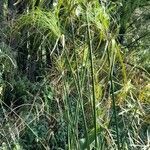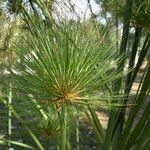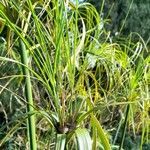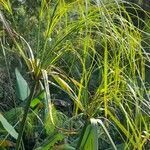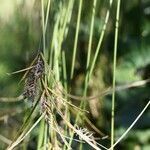Herbs, perennial, rhizomatous, stout. Culms roundly trigonous, 200–350 cm × 15–50 mm, glabrous. Leaves bladeless. Inflorescences: spikes loosely cylindric, 15–40 × 8–16 mm; rays 5–8, ascending to erect, stiff,20–30 cm; 2d order rays 5–15 cm; bracts 10–12, ascending at 30–60°, flat, (8–) 20–45 cm × 4–12 mm; 2d order bracts (5–)15–25 cm × 1.5–5 mm; rachilla persistent, separating laterally, remaining firmly attached basally, wings 0.3–0.4 mm wide. Spikelets (15–)50–80, slightly compressed, linear, ± quadrangular, 5–12 × 0.6–1.4 mm; floral scales 8–20, appressed, reddish beside 5-ribbed green medial part, white to hyaline near margins, ovate, 1.8–2.2 × 1.2–1.5 mm, apex acute to obtuse. Flowers: anthers 0.7–1 mm (connective prolonged beyond anther as red subulate appendage 0.2–0.5 mm, its apex sometimes setose); styles 0.2–0.5 mm; stigmas (0.8–)1.2–1.8 mm. Achenes pale brown, sessile, oblong, 0.9–1 × 0.4–0.5 mm, apex scarcely apiculate, surfaces puncticulate.
More
Plants large and stout, the culms 1-2 m. high; leaves reduced to basal sheaths; bracts long and leaf-like, 1-2 cm. wide; inflorescence very large, the spikes elon-gate, lax; spikelets slender, 4-1Q mm. long, 8-to 14-flowered, rachilla winged; scales obtuse, stramineous; achene oblong-ellipsoid, trigonous, 1 mm. long, the axial face concave, oblong, yellowish, densely papillose.
